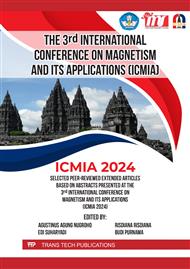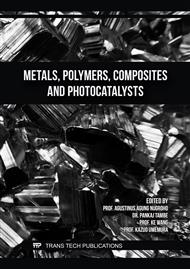[1]
Suharto, B., Dewi, L., Mustaqiman, A. N., & Marjo, T. R. A. K. (2019). The study of water quality status in the ngebrong river with physical and chemical parameters in the Tawangsari Barat region, Pujon district, Malang regency. Indonesian Journal of Urban and Environmental Technology, 2(2), 164-180.
DOI: 10.25105/urbanenvirotech.v2i2.4361
Google Scholar
[2]
Obotey Ezugbe, E., & Rathilal, S. (2020). Membrane technologies in wastewater treatment: a review. Membranes, 10(5), 89.
DOI: 10.3390/membranes10050089
Google Scholar
[3]
Saravanan, A., Kumar, P. S., Jeevanantham, S., Karishma, S., Tajsabreen, B., Yaashikaa, P. R., & Reshma, B. (2021). Effective water/wastewater treatment methodologies for toxic pollutants removal: Processes and applications towards sustainable development. Chemosphere, 280, 130595.
DOI: 10.1016/j.chemosphere.2021.130595
Google Scholar
[4]
Xue, Y., Kamali, M., Zhang, X., Askari, N., De Preter, C., Appels, L., & Dewil, R. (2023). Immobilization of photocatalytic materials for (waste) water treatment using 3D printing technology–advances and challenges. Environmental Pollution, 316, 120549.
DOI: 10.1016/j.envpol.2022.120549
Google Scholar
[5]
Singh, P., Mohan, B., Madaan, V., Ranga, R., Kumari, P., Kumar, S., ... & Kumar, K. (2022). Nanomaterials photocatalytic activities for waste water treatment: a review. Environmental Science and Pollution Research, 29(46), 69294-69326..
DOI: 10.1007/s11356-022-22550-7
Google Scholar
[6]
Chen, D., Cheng, Y., Zhou, N., Chen, P., Wang, Y., Li, K., ... & Ruan, R. (2020). Photocatalytic degradation of organic pollutants using TiO2-based photocatalysts: A review. Journal of Cleaner Production, 268, 121725.
DOI: 10.1016/j.jclepro.2020.121725
Google Scholar
[7]
Arora, I., Chawla, H., Chandra, A., Sagadevan, S., & Garg, S. (2022). Advances in the strategies for enhancing the photocatalytic activity of TiO2: Conversion from UV-light active to visible-light active photocatalyst. Inorganic Chemistry Communications, 143, 109700.
DOI: 10.1016/j.inoche.2022.109700
Google Scholar
[8]
Krakowiak, R., Frankowski, R., Mylkie, K., Mlynarczyk, D. T., Ziegler-Borowska, M., Zgoła-Grześkowiak, A., & Goslinski, T. (2022). TiO2–Fe3O4 composite systems—preparation, physicochemical characterization, and an attempt to explain the limitations that arise in catalytic applications. Applied Sciences, 12(17), 8826.
DOI: 10.3390/app12178826
Google Scholar
[9]
Ilyas, S., Abdullah, B., & Tahir, D. (2020). Enhancement of absorbing frequency and photo-catalytic performance by temperature treatment of composites Fe3O4-AC nanoparticle. Advanced Powder Technology, 31(3), 905-913.
DOI: 10.1016/j.apt.2019.11.007
Google Scholar
[10]
Taufiq, A., Nuroni, M. S., Hidayat, N., Subadra, S. U. I., Sunaryono, S., Hidayat, A., & Yudyanto, Y. (2020). Effect of polyaniline on structural and optical characteristics of Fe3O4 and TiO2 nanoparticles. Key Engineering Materials, 851, 9-15.
DOI: 10.4028/www.scientific.net/kem.851.9
Google Scholar
[11]
Ahmad, W., Qaiser, S., Ullah, R., Mohamed Jan, B., Karakassides, M. A., Salmas, C. E., ... & Ikram, R. (2020). Utilization of tires waste-derived magnetic-activated carbon for the removal of hexavalent chromium from wastewater. Materials, 14(1), 34.
DOI: 10.3390/ma14010034
Google Scholar
[12]
Jjagwe, J., Olupot, P. W., Menya, E., & Kalibbala, H. M. (2021). Synthesis and application of granular activated carbon from biomass waste materials for water treatment: A review. Journal of Bioresources and Bioproducts, 6(4), 292-322.
DOI: 10.1016/j.jobab.2021.03.003
Google Scholar
[13]
Mohamad Idris, N. H., Rajakumar, J., Cheong, K. Y., Kennedy, B. J., Ohno, T., Yamakata, A., & Lee, H. L. (2021). Titanium dioxide/polyvinyl alcohol/cork nanocomposite: a floating photocatalyst for the degradation of methylene blue under irradiation of a visible light source. ACS omega, 6(22), 14493-14503.
DOI: 10.1021/acsomega.1c01458
Google Scholar
[14]
Varnagiris, S., Urbonavicius, M., Sakalauskaite, S., Demikyte, E., Tuckute, S., & Lelis, M. (2021). Photocatalytic inactivation of salmonella typhimurium by floating carbon-doped TiO2 photocatalyst. Materials, 14(19), 5681.
DOI: 10.3390/ma14195681
Google Scholar
[15]
Wang, R., Hu, L., Wang, M., Wei, Y., Xu, Y., Zhang, X., & Chen, J. (2023). The selection of floating photocatalyst carrier and algae inhibition effect of Karenia mikimotoi based on SNP-TiO2@ Cu-MOF under visible light. Chemosphere, 343, 140276.
DOI: 10.1016/j.chemosphere.2023.140276
Google Scholar
[16]
Wang, L., Cui, H., Wang, L., Han, X., & Wang, X. (2021). Floating microparticles of ZnIn2S4@ hollow glass microsphere for enhanced photocatalytic activity. International Journal of Hydrogen Energy, 46(15), 9678-9689.
DOI: 10.1016/j.ijhydene.2020.10.015
Google Scholar
[17]
Lee, Y. J., Lee, C. G., Kang, J. K., Park, S. J., & Alvarez, P. J. (2021). Simple preparation method for Styrofoam–TiO 2 composites and their photocatalytic application for dye oxidation and Cr (vi) reduction in industrial wastewater. Environmental Science: Water Research & Technology, 7(1), 222-230.
DOI: 10.1039/d0ew00787k
Google Scholar
[18]
Manjunatha, M., & Mahalingam, H. (2023). Upcycling of waste EPS beads to immobilized codoped TiO2 photocatalysts for ciprofloxacin degradation and E. coli disinfection under sunlight. Scientific Reports, 13(1), 14631.
DOI: 10.1038/s41598-023-41705-1
Google Scholar
[19]
Deshmukh, S. P., Kale, D. P., Kar, S., Shirsath, S. R., Bhanvase, B. A., Saharan, V. K., & Sonawane, S. H. (2020). Ultrasound assisted preparation of rGO/TiO2 nanocomposite for effective photocatalytic degradation of methylene blue under sunlight. Nano-Structures & Nano-Objects, 21, 100407.
DOI: 10.1016/j.nanoso.2019.100407
Google Scholar
[20]
Zhu, L., Kong, X., Yang, C., Ren, B., & Tang, Q. (2020). Fabrication and characterization of the magnetic separation photocatalyst C-TiO2@ Fe3O4/AC with enhanced photocatalytic performance under visible light irradiation. Journal of hazardous materials, 381, 120910.
DOI: 10.1016/j.jhazmat.2019.120910
Google Scholar
[21]
Guo, W., Ma, J., Cao, X., Tong, X., Liu, F., Liu, Y., ... & Liu, S. (2017). Amperometric sensing of hydrazine using a magnetic glassy carbon electrode modified with a ternary composite prepared from Prussian blue, Fe 3 O 4 nanoparticles, and reduced graphene oxide. Microchimica Acta, 184, 3163-3170.
DOI: 10.1007/s00604-017-2289-x
Google Scholar
[22]
Dilebo, J. (2020). A mini review on factors affecting particle size, sphericity and pore size of mesoporous silica nanoparticles. 2020; 11: 15, 20.
Google Scholar
[23]
Yang, Y., Xu, L., Wang, H., Wang, W., & Zhang, L. (2016). TiO2/graphene porous composite and its photocatalytic degradation of methylene blue. Materials & Design, 108, 632-639.
DOI: 10.1016/j.matdes.2016.06.104
Google Scholar
[24]
Wang, W., Yu, J., Xiang, Q., & Cheng, B. (2012). Enhanced photocatalytic activity of hierarchical macro/mesoporous TiO2–graphene composites for photodegradation of acetone in air. Applied Catalysis B: Environmental, 119, 109-116.
DOI: 10.1016/j.apcatb.2012.02.035
Google Scholar
[25]
Majid, F., Shahin, A., Ata, S., Bibi, I., Malik, A., Ali, A., ... & Nazir, A. (2021). The effect of temperature on the structural, dielectric and magnetic properties of cobalt ferrites synthesized via hydrothermal method. Zeitschrift für Physikalische Chemie, 235(10), 1279-1296.
DOI: 10.1515/zpch-2020-1751
Google Scholar
[26]
Asiri, S., Sertkol, M., Güngüneş, H., Amir, M., Manikandan, A., Ercan, İ., & Baykal, A. (2018). The temperature effect on magnetic properties of NiFe 2 O 4 nanoparticles. Journal of Inorganic and Organometallic Polymers and Materials, 28, 1587-1597.
DOI: 10.1007/s10904-018-0813-z
Google Scholar
[27]
Purnama, B., & Wijayanta, A. T. (2019). Effect of calcination temperature on structural and magnetic properties in cobalt ferrite nano particles. Journal of King Saud University-Science, 31(4), 956-960.
DOI: 10.1016/j.jksus.2018.07.019
Google Scholar
[28]
Stepanova, A., Tite, T., Ivanenko, I., Enculescu, M., Radu, C., Culita, D. C., ... & Galca, A. C. (2023). TiO2 Phase Ratio's Contribution to the Photocatalytic Activity. ACS omega, 8(44), 41664-41673.
DOI: 10.1021/acsomega.3c05890
Google Scholar
[29]
Li, Y., Yi, H., Tang, X., Liu, X., Wang, Y., Cui, B., & Zhao, S. (2016). Study on the performance of simultaneous desulfurization and denitrification of Fe3O4-TiO2 composites. Chemical Engineering Journal, 304, 89-97.
DOI: 10.1016/j.cej.2016.06.035
Google Scholar
[30]
Bahjat, H. H., Ismail, R. A., & Sulaiman, G. M. (2022). Photodetection properties of populated Fe3O4@ TiO2 core–shell/Si heterojunction prepared by laser ablation in water. Applied Physics A, 128(1), 8.
DOI: 10.1007/s00339-021-05139-8
Google Scholar
[31]
Sunaryono, S., Fitriana, D. R., Novita, L. R., Hidayat, M. F., Hartatiek, H., Mufti, N., & Taufiq, A. (2020, July). The effect of Fe3O4 concentration to photocatalytic activity of Fe3O4@ TiO2-PVP core-shell nanocomposite. In Journal of Physics: Conference Series (Vol. 1595, No. 1, p.012003). IOP Publishing.
DOI: 10.1088/1742-6596/1595/1/012003
Google Scholar
[32]
Gunlazuardi, J., Fisli, A., Ridwan, R., Krisnandi, Y. K., & Robert, D. (2021). Magnetically separable Fe3O4/SiO2/TiO2 photocatalyst composites prepared through hetero agglomeration for the photocatalytic degradation of paraquat. Makara Journal of Science, 25(4), 6.
DOI: 10.7454/mss.v25i4.1277
Google Scholar
[33]
Wang, X., Wang, X., Zhao, J., Song, J., Zhou, L., Wang, J., ... & Chen, Y. (2017). An alternative to in situ photocatalytic degradation of microcystin-LR by worm-like N, P co-doped TiO2/expanded graphite by carbon layer (NPT-EGC) floating composites. Applied Catalysis B: Environmental, 206, 479-489.
DOI: 10.1016/j.apcatb.2017.01.046
Google Scholar
[34]
Moosavi, S., Li, R. Y. M., Lai, C. W., Yusof, Y., Gan, S., Akbarzadeh, O., ... & Johan, M. R. (2020). Methylene blue dye photocatalytic degradation over synthesised Fe3O4/AC/TiO2 nano-catalyst: degradation and reusability studies. Nanomaterials, 10(12), 2360.
DOI: 10.3390/nano10122360
Google Scholar
[35]
Radziuk, D., & Möhwald, H. (2016). Ultrasonically treated liquid interfaces for progress in cleaning and separation processes. Physical Chemistry Chemical Physics, 18(1), 21-46.
DOI: 10.1039/c5cp05142h
Google Scholar
[36]
Zhou, Y., Sun, Z., Jiang, L., Chen, S., Ma, J., & Zhou, F. (2020). Flexible and conductive meta-aramid fiber paper with high thermal and chemical stability for electromagnetic interference shielding. Applied Surface Science, 533, 147431.
DOI: 10.1016/j.apsusc.2020.147431
Google Scholar



